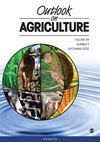农业土壤生物多样性与自然拟态;隐喻的力量?
IF 2.6
3区 经济学
Q1 AGRICULTURE, MULTIDISCIPLINARY
引用次数: 12
摘要
近年来,人们对土壤生物多样性及其对可持续粮食生产的重要性的关注显著增加。特别是,集约化农业、土地退化和气候变化造成的土壤生物多样性丧失引起了人们的关注,因为预计会对生态系统服务、粮食安全和人类健康产生负面影响。其结果是对“基于自然”的做法的强烈需求,这些做法可以刺激土壤生物多样性或有益的土壤生物并增强土壤健康。在这里,我们研究了关于土壤生物学在可持续土壤管理中的作用的流行观点的起源,以及它们解决与农业相关的关键全球挑战的潜力。本文讨论了这一观点的三个例子:1)较高的真菌:细菌(F:B)生物量比有利于土壤碳储存和养分保持;(2)集约农业导致土壤生物多样性下降,不利于可持续粮食生产;(3)接种丛枝菌根真菌减少农业对合成肥料的依赖。我们的分析表明,生态理论,特别是E.P. Odum(1969)关于生态演替的假设,如何启发了基于自然生态系统(土壤生物学)模仿的农业实践和商业产品的推广。然而,我们对科学文献的阅读表明,关于高F:B比率、土壤生物多样性和接种有益微生物对土壤健康和可持续农业生产的重要性的流行主张不能被概括,需要仔细考虑局限性和可能的权衡。我们认为,鉴于迫切需要实现维持粮食生产和自然资源的真正解决方案,与将自然作为可持续性隐喻的规范性使用相关的二分法和陷阱可能适得其反。最后,对土壤生态学研究和农业土壤可持续管理的意义进行了讨论。本文章由计算机程序翻译,如有差异,请以英文原文为准。
Soil biodiversity and nature-mimicry in agriculture; the power of metaphor?
Attention to soil biodiversity and its importance for sustainable food production has markedly increased in recent years. In particular, the loss of soil biodiversity as a consequence of intensive agriculture, land degradation and climate change has raised concerns due to the expected negative impacts on ecosystem services, food security and human health. The result is a strong demand for ‘nature-based’ practices that stimulate soil biodiversity or beneficial soil organisms and enhance soil health. Here, we examine the origin of popular ideas on the role of soil biology in sustainable soil management, as well as their potential to address key global challenges related to agriculture. Three examples of such ideas are discussed: 1) a higher fungal:bacterial (F:B) biomass ratio favours soil carbon storage and nutrient conservation; (2) intensive agricultural practices lead to a decline in soil biodiversity with detrimental consequences for sustainable food production; (3) inoculation with arbuscular mycorrhizal fungi reduces agriculture's dependency on synthetic fertilizers. Our analysis demonstrates how ecological theories, especially E.P. Odum's ( 1969) hypotheses on ecological succession, have inspired the promotion of agricultural practices and commercial products that are based on the mimicry of (soil biology in) natural ecosystems. Yet our reading of the scientific literature shows that popular claims on the importance of high F:B ratios, soil biodiversity and the inoculation with beneficial microbes for soil health and sustainable agricultural production cannot be generalized and require careful consideration of limitations and possible trade-offs. We argue that dichotomies and pitfalls associated with the normative use of nature as a metaphor for sustainability can be counterproductive given the urgency to achieve real solutions that sustain food production and natural resources. Finally, implications for soil ecology research and sustainable soil management in agriculture are discussed.
求助全文
通过发布文献求助,成功后即可免费获取论文全文。
去求助
来源期刊

Outlook on Agriculture
农林科学-农业综合
CiteScore
5.60
自引率
13.30%
发文量
38
审稿时长
>36 weeks
期刊介绍:
Outlook on Agriculture is a peer reviewed journal, published quarterly, which welcomes original research papers, research notes, invited reviews and commentary for an international and interdisciplinary readership. Special attention is paid to agricultural policy, international trade in the agricultural sector, strategic developments in food production, the links between agricultural systems and food security, the role of agriculture in social and economic development, agriculture in developing countries and environmental issues, including natural resources for agriculture and climate impacts.
 求助内容:
求助内容: 应助结果提醒方式:
应助结果提醒方式:


